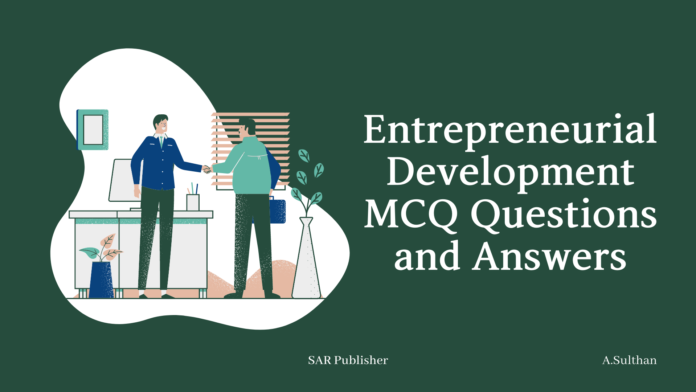Entrepreneurial Development MCQ Questions and Answers Part – 1
Entrepreneurial Development MCQ Questions and Answers Part – 2
Entrepreneurial Development MCQ Questions and Answers Part – 3
101. Institutional agencies grant financial assistance to small scale industries for _________.
A. participation in equity capital only.
B. acquisition of fixed assets.
C. working capital assistance.
D. all of the above.
ANSWER: D
102. Under section 80J of the income tax act, 1961, small-scale industries are exempted from the payment of income tax on their profits at ___________.
A. 6% p.a.
B. 6% p.m.
C. 5% p.a.
D. 5% p.a.
ANSWER: A
103. The policy which stressed the role of cottage and small-scale industries for balanced industrial development of the country is ___________.
A. IPR 1940.
B. IPR 1948.
C. IPR 1956.
D. IPR 1977.
ANSWER: B
104. The policy which emphasized the need of promoting small-scale industries through integrated industrial development is_____________.
A. IPR 1948.
B. IPR 1956.
C. IPR 1977.
D. IPR 1980.
ANSWER: C
105. The small scale unit wishing to export has to obtain exporters code number from _________.
A. The Reserve Bank of India.
B. The Central Bank of India.
C. Any Regional Bank.
D. Any International Bank.
ANSWER: A
106. The expenses incurred on the setting up of the enterprise are called as _________.
A. Cost of financing.
B. Cost of promotion..
C. Cost of fixed assets.
D. Cost of current assets.
ANSWER: B
107. Over – capitalization arises due to___________.
A. excess of assets over the liabilities.
B. excess of liabilities over the assets.
C. actual earnings are lower than the expected earnings.
D. actual earnings are higher than the expected earnings.
ANSWER: C
108. Under-capitalization arises due to __________.
A. excess of assets over the liabilities.
B. excess of liabilities over the assets.
C. actual capitalization is higher than the proper capitalization.
D. actual capitalization is lower than the proper capitalization.
ANSWER: D
109. Which of the following leads to over-capitalization?
A. under-estimation of the initial rate of earnings.
B. acquiring fixed assets on excessive amounts.
C. using lower-rate of capitalization.
D. underestimation of required funds.
ANSWER: B
110. Which of the following leads to under-capitalization?
A. raising of more money by issue of shares.
B. acquiring fixed assets on excessive amounts.
C. over-estimation of earnings for enterprise.
D. under-estimation of the initial rate of earnings.
ANSWER: D
111. Business means ________.
A. Commerce.
B. industry and commerce.
C. trade and commerce.
D. selling and buying of goods.
ANSWER: B
112. A valid definition of a business purpose is to ______.
A. create a customer.
B. maximize profits.
C. serve the society.
D. increase the wealth of the firm.
ANSWER: B
113. Reserve bank of India is a/an _______.
A. statutory corporation.
B. company limited by guarantee.
C. company limited by shares.
D. unlimited company.
ANSWER: A
114. A public corporation means _____.
A. public company.
B. government company.
C. statutory corporation.
D. department of union government
ANSWER: C
115. Promoter is a person who ________.
A. takes part in the incorporation of a company.
B. is a director.
C. is a relative of the managing director.
D. works to publicity to the company.
ANSWER: A
116. The term Capitalization is used in relation to ______.
A. sole-proprietorship.
B. Partnership.
C. joint-stock companies.
D. co-operative societies
ANSWER: C
117. Which of the following sources is not use for medium-term financing?
A. Issue of equity shares.
B. Issue of debentures.
C. Term loans from banks.
D. Sale of current asset.
ANSWER: A
118. Which of the following securities proves a burden on the finances of the company, when the company is not
earning profits?
A. Equity shares.
B. Preference shares.
C. Redeemable preference shares.
D. Debentures.
ANSWER: D
119. Investment in which of the following is most risky?
A. Equity shares.
B. Preference shares.
C. Debentures.
D. Land.
ANSWER: C
120. A project, which may not add to the existing profits, should be financed by _________
A. debentures.
B. preference share capital.
C. equity capital.
D. public deposits.
ANSWER: A
121. Business risks can be ______.
A. reduced.
B. avoided.
C. ignored.
D. erased.
ANSWER: A
122. O & M refers to ____________
A. overall efficiency of business.
B. efficiency of office and administrative work.
C. office work measurement.
D. office and management study.
ANSWER: D
123. The oldest form of business organization is ______.
A. Partnership.
B. sole proprietorship.
C. joint-stock company.
D. co-operative undertaking.
ANSWER: B
124. Memorandum of association of a firm contains _______.
A. rules regarding the internal management of the company.
B. rules regarding the constitution and activities of the company.
C. rules regarding the external management.
D. rules regarding the constitution.
ANSWER: B
125. A Company is called an artificial person because ____.
A. it does not have the shape of a natural person.
B. it cannot be used in the court of law.
C. it is invisible and intangible.
D. it exists only in contemplation of law.
ANSWER: C
126. The charter of a company is its ______.
A. prospectus.
B. statement lieu of prospectus.
C. memorandum of association.
D. articles of association.
ANSWER: A
127. A person owning and running a small firm, is known as________.
A. A manager-owner.
B. An owner-manager.
C. A professional adapter.
D. An enterprise worker.
ANSWER: B
128. Which of the following is a characteristic typical of _________?Most entrepreneurs
A. Choose high-risk ventures.
B. Choose low-risk ventures.
C. Choose moderate (or calculated) risk ventures.
D. Choose no risk ventures.
ANSWER: C
129. The UK government has implemented a number of policies to encourage Entrepreneurship in schools.
One such initiative is _________.
A. Young Enterprise.
B. Youth venture.
C. Young Business.
D. Young Initiative.
ANSWER: A
130. One of the disadvantages of a franchise business for a franchisee is ________.
A. Lack of independence.
B. Franchise businesses typically have a high failure rate.
C. Lack of brand identity.
D. Training is not normally provided by the franchisor.
ANSWER: A
131. The Markets and Competitors section of a business plan should contain ____________.
A. A statement of the target market.
B. The size of each market segment.
C. The key characteristics of buyers in each business segment.
D. All the above.
ANSWER: D
132. As a new company grows, the entrepreneur will need to _________.
A. be responsive to changes in the market.
B. ensure financial controls are maintained.
C. build a management team.
D. all the above.
ANSWER: D
133. An entrepreneur into the hosiery business found out the reason his hosiery was not selling was due to its color. What could be the best source of this information?
A. Supplier.
B. Retailer.
C. Competition.
D. Government bureau.
ANSWER: B
134. Entrepreneurship can best be described as _________.
A. a process that requires setting up a business.
B. taking a significant risk in a business context.
C. having a strong vision.
D. a process involving innovation, new products or services, and value creation.
ANSWER: D
135. ____________, which is included in the project cost, is estimated on the basis of the year when the enterprise breaks even.
A. working capital
B. cost of capital
C. cost of production
D. cost of equity
ANSWER: A
136. The minimum amount of——————, irrespective of such private participation, could be specified at a minimum 17.5 per cent of project costs by lending institutions.
A. bank loans
B. promotors contribution
C. fixed capital
D. working capital
ANSWER: B
137. __________ set up for the purpose of financing, facilitating, and promoting foreign trade of India.
A. Repco bank
B. SBI
C. EXIM bank
D. HDFC
ANSWER: C
138. Which of the following is not considered to be a characteristic of a project?
A. An established objective
B. Complex tasks
C. A clear beginning and end
D. Only for internal use
ANSWER: D
139. Project management is ideally suited for a business environment requiring all of the following except _________.
A. Flexibility
B. Innovation
C. speed
D. Repetability
ANSWER: D
140. Integration of project management with the organization takes place with the _______________.
A. master budjet
B. strategic plan
C. Process of managing actual projects
D. both b and c
ANSWER: D
141. The content of the final report typically includes the following topics __________.
A. Executive summary
B. review and analysis
C. recommendations
D. If all the above are correct.
ANSWER: D
142. Project mission and objectives, procedures and systems used, and organization resources used typically appear in the _____ section of the final project report.
A. Analysis
B. Recommendation
C. lessons learned
D. financial feasibility
ANSWER: A
143. what are the components of the project report ________.
A. requirement of funds
B. location
C. manpower
D. all the above
ANSWER: D
144. market potential of the project report includes ________.
A. demand and supply conditions
B. market strategy
C. after-sales service
D. all the above
ANSWER: D
145. Every entrepreneur should draw an _______ for his project to ensure the timely completion of all
activities involved in setting up an enterprise.
A. cost structure
B. implementation plan
C. market structure
D. production structure
ANSWER: B
146. ______________ describes the direction, the enterprise is going in, what its goals are, where it wants to be, and how it is going to get there.
A. project report
B. technical analysis
C. market analysis
D. financial analysis
ANSWER: A
147. Today, many companies are using managerial techniques that are designed to encourage _________.
A. increasing profits
B. legal compliances
C. Ethical behaviour
D. shareholders value
ANSWER: C
148. Entrepreneurial development is the key to achieve all-round __________ through acceleration of industrial and entrepreneurial activities.
A. increase in profits
B. economic development
C. shareholders value
D. business development
ANSWER: B
149. SWOT Analysis is a _____________ tool
A. Conceptual
B. Modern
C. Scientific
D. Traditional
ANSWER: A
150. NABARD is a Bank for _____________ development
A. Urban
B. Agricultural and Rural
C. Scientific
D. Agriculture and research
ANSWER: B


